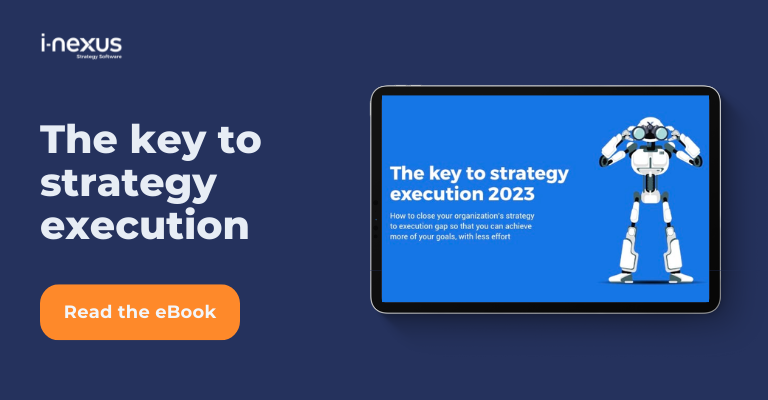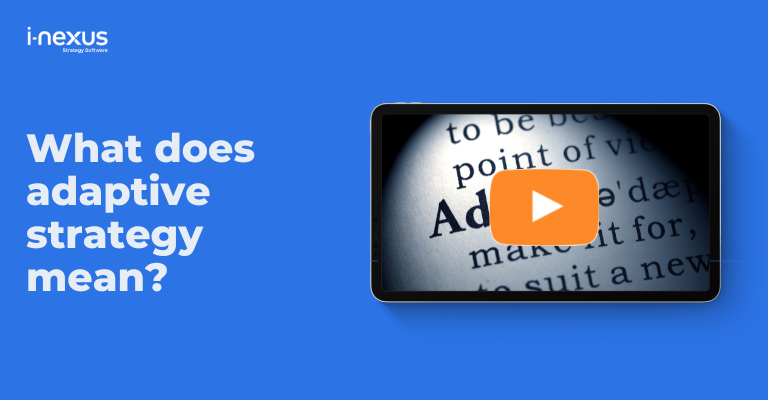There is always choice in how we move forward in business and the same holds true for bringing our strategies to life. Here are some ideas for how you can approach strategic implementation in your organization.
Written by: Deborah Biscomb, Head of Marketing
In this overview we're examining a number of ways which you can utilize your past performance and the works of academics to plot a course for successful implementation.
However, whether you consider the reasons for failure or look to academic models such as the crescive model, the end point must remain the same - translating your strategic vision and initiatives into operational reality.
Implementation failure vs. theory
There are two dimensions to approaching strategic implementation in your organization - failure and theory.
The first looks at failure – that being, the factors and examples of failure to be wary of and addressed before they become an issue for your organization’s implementation.
The second is more theoretical. It is a list of five suggestions that can be made, based on academic works, which offer different approaches to successful implementation.
Failure factors
Whether your organization has formally adopted continuous improvement or taken inspiration from its mantra of failure is progress, you can absolutely look to the improvement world for guidance on how to be successful with strategy implementation.
The reason for this is quite simple - similar to the 5 Whys technique where you repeatedly ask why a process has failed, you can look at past strategic implementations (internally and externally) and arrive at some macro-level conclusions as to why failure could take place.
These include:
- Ownership: If you’re not invested in the strategy, there will be a disconnect. When everyone has skin in the game, there’s more excitement, passion and care for implementation.
- Communication: If the strategy is formed behind closed doors and actions are simply supplanted onto workers without involvement, understanding will be minimal and morale lower.
- Fire fighting: Owners and managers are facing business as usual and firefighting every day – without time to breathe and implement there will never be true acknowledgement of and striving toward strategic objectives.
- Change: The strategy is seen as change – change is resisted by default. Without explanation, engagement and ownership the business will have little investment in implementing the strategy – after all, it is simply seen as a ‘management process’.
- Less is more: By using catchball and other techniques you can involve key stakeholders from the top down in formulating the strategy, making implementation easier.
Should you not do this, you’re likely to have an abundance of objectives and actions and not enough resource and time to achieve these. - Meaning: If the business doesn’t buy into your vision, mission and strategy then securing employee buy in and a successful implementation are ever further away.
- One and done: Strategy is an annual ‘thing’ and not open for discussion or engagement outside of the c-suite.
- Strategy = execution: Implementation isn’t part of your process. The strategy leads to projects which leads to results. No mind is paid to implementation.
These failures are neither mutually exclusive nor reserved for particular industries and organizational structures.
No, they are all too common in their occurrence but, by listing and being mindful of the warning signs of their presence, you should use this as a checklist to measure your implementation against.
Theoretical food for thought
Much has been written about strategy’s formulation and execution, but implementation is an area mostly left untouched.
However, in 1982 two Stanford University professors (Bourgeois III and Brodwin) sought to conceptualize five models to address what they felt was that ‘elusive phenomenon’ of strategy implementation.
With the above and the following in mind, you can form your own approach to strategy implementation:
1. The commander model (CEO led formulation and implementation)
This model is perhaps the most traditional strategic management approach.
The CEO and leadership team creates a strategy and works with line management to implement the strategy.
The CEO is a ‘rational actor’, meaning their role atop the corporate tree means it is only rational for line management to implement the strategy.
However, with the evolution of organizational structures, and de-centralization of CEO and organizational power, this model is outdated.
It does little to acknowledge how key stakeholders beyond senior management can, and should, contribute to implementation.
2. The change model (monetary compensation)
The premise of this model is simple.
Offer monetary or another form of compensation to incentivize the organization to implement your strategy.
However, obviously, this necessitates that all workers are eager to be incentivized vs. wanting to ‘just do their job’.
3. The collaborative model (group decision making on strategy with senior managers)
In light of tools such as catchball and OKR’s bottom-up goal setting, actively engaging your organization in strategy setting can induce more engagement in the implementation stage.
After all, it goes a long way to overcoming the common failure of ‘one and done’ as identified above.
4. The cultural model (introducing cultural shifts to succeed)
Here, implementation is made easier through the right culture. What is the right culture? That is dependent on your business. Perhaps it could be to shift your business policy towards being customer centric.
That shift will require your product, marketing, sales and customer success team to be revolutionized. That change can lead to your teams being more involved in wanting to implement the strategy if they see the value.
5. The crescive model (bottom-up evolution of strategy through implementation)
The final model asks how CEOs can empower the entire business to develop, champion, implement and execute effective strategies.
This is a bottom-up evolution of strategic implementation.
The CEO (or an office supporting strategy) acts as the arbiter. They will receive suggestions on strategy and implementation, and choose the most appropriate to support their vision.
Not only does this empower staff, it also provides ownership – an ever-evasive element of strategy.
However, this does require an organization with the correct policy, processes, resources and structure, underpinned by staff who want to be involved. This could lead to an over-abundance of suggestions, bi-partisanship and back-fire.
Theory or failure - how should you approach your strategy's implementation?
Regardless of the approach, it is clear that strategic implementation comes down to engagement in the process, your business and its resources.
Implementation is the engine, cam belt, gear box and everything else that brings the shell of the car (your strategy) to life and sets it for forward motion (execution).
If you cannot drive your car to your destination, no matter how it looks, it isn’t going to help you.
And ultimately, while it pays to acknowledge your failures and apply theoretical advice, you must, above all else, avoid anyone ever saying this to you again…
“Great strategy, shame about the implementation”
Okumus and Roper, 1998
Learn more about Strategy Execution Management
Click here to visit our strategy execution knowledge hub, filled with content to support you in embracing the 'no normal' of strategy in the 2020s and beyond, or explore these recommendations:
- What is Hoshin Kanri? The definitive answer: Learn about Hoshin's origins, the seven steps of execution, how Hoshin is different from policy and goal deployment, plus much more
- Hoshin Kanri - OGSM - OKR: A case of apples and oranges?: Uncover the similarities between Hoshin Kanri, OGSM and OKR in our comparison feature.
- Download our Hoshin Kanri eBook: Read how Hoshin Kanri is supporting organizations to drive great business results, how two businesses have used the methodology to build their business systems, case studies and more.
About the author
Deborah Biscomb is Head of Marketing at i-nexus. Deborah has wide-ranging experience of markets such as retail, manufacturing, financial services, public sector, telecommunications, energy and utilities, distribution and logistics.
As Head of Marketing, her drive is to raise awareness and understanding of the challenges facing enterprises in controlling their strategy and driving superior results.
If you’d like to talk more about Strategy Execution, reach out to Deborah on deborah.biscomb@i-nexus.com or connect with her on LinkedIn for the latest strategic insights.




